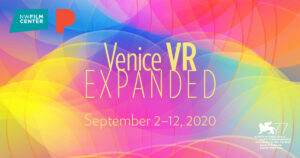COVID-19 forced many art and film festivals to go virtual in 2020. For VR this move was not entirely negative. Some festivals used the transition to online editions for setting up impressive showcases of their immersive sidekicks. Cinematic VR suddenly came into a position to represent branded festival locations like Cannes or Venice in online festivities. Expanded cinema is about to establish its very own festival journey throughout the year by giving a second life to their traditional twins of real-world events.
The Tribeca Film Festival started this move by going online in springtime. Cannes XR followed by organizing a purely virtual event in the Museum of Other Realities. Venice VR Expanded partnered up with Viveport for a showcase of its immersive selection and brought VR installations back to the real world with satellite events in selected cities all around the globe. Ars Electronica split up into countless activity streams by integrating local avant-garde festivals and real-world initiatives all over the world into their digital hub. NewImages Festival went onto the social media platform VRchat for immersive showcases and meetup celebrations.
Most of the traditional film festivals already set up separate programs for VR experiences and VR 360 cinematic before. In comparison to the more interactive VR gaming productions, the festival selections clearly focus on storytelling. Most of the short films stick with forced camera controls for the viewer. Cinematic VR strongly relies on placing the camera at certain spots and letting the viewer turn around for focusing the action. Cutting between scenes literally means a change of scenery. 360° captured works therefore mostly deal with location-based documentaries or empathy triggering scenarios. Interactivity is reduced to a simple choice of perspective, a change of setting or a decision between plot forks. This also holds for short 3D animation works, often playing with perspectives of scale while following the puppet characters from room to room in a dollhouse blueprint of the storyline. Their basic understanding of VR is still related to a watching experience. More immersive and viewer engaging artworks already trespass the borderline from film to games. Tribeca now acknowledges this tendency by setting up a game-exclusive award program for next year’s edition.
Normally, all of these selections are presented at the respective festival location. Their line-up in digital editions becomes a bit repetitive for homestay viewers. On the other hand, local satellite installations open up the festivals’ and the medium’s air of exclusivity for visitors not disposing of VR equipment at home, yet. Apart from its well-known artful experimentation platform, this year’s Ars Electronica’s most interesting program offerings were guided online tours through media art locations and locally organized workshops on the future of tourism. This reconnects the digital expansion to its real-world festival origin. This also opens up a very prospective application field for VR in the ‘new normal’ and beyond.








